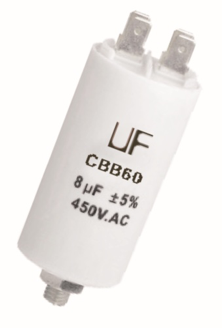We can see starting capacitor and running capacitor in motor application, what are their differences?The differences between the starting capacitor and the running capacitor in a single-phase motor are as follows:
The capacitance of the starting capacitor is typically larger than that of the running capacitor, generally 3 to 10 times greater.
The starting capacitor functions during the startup of the single-phase motor, causing the current in the starting winding to lead the current in the running winding by 90 electrical degrees in time and space, creating a phase difference. The running capacitor, on the other hand, operates during the motor's normal running state, providing capacitive compensation to balance the currents between the main and auxiliary windings.
Since the starting capacitor operates only momentarily during startup, its voltage rating must be above 250V. In contrast, the running capacitor operates continuously during normal operation, requiring a higher voltage rating of at least 400V.
Starting Capacitor: To ensure proper startup, a single-phase motor often relies on the starting capacitor, which provides torque and a rotating magnetic field during startup. Once the motor reaches a certain speed, the starting capacitor is disconnected from the circuit via a centrifugal switch and is no longer in series with it.
Running Capacitor: During operation, the running capacitor helps balance the motor's phase, ensuring smoother and more stable performance.
Starting capacitors generally have larger capacitance values, with common specifications such as 105μF, 205μF, and 305μF. Running capacitors have relatively smaller capacitance values, typically ranging from 5μF, 6μF, to 8μF.
The starting capacitor and running capacitor are positioned differently within the motor. The starting capacitor is connected to one end of the auxiliary winding, while the running capacitor is connected to one end of the main winding.
The starting capacitor is wired with one terminal connected to the auxiliary winding and the other terminal connected to the centrifugal switch.
The running capacitor is wired with one terminal connected to the main winding and the other terminal connected to the opposite side of the centrifugal switch.
Starting Capacitor: When power is applied, the starting capacitor, connected to the auxiliary winding, begins working. As the motor speed increases, the centrifugal switch gradually reduces the voltage across the starting capacitor until it disconnects the auxiliary winding from the circuit. At this point, the motor transitions to normal operation.
Running Capacitor: Once the motor is running normally, the running capacitor begins functioning. Connected to the main winding, it receives power and operates under the influence of the centrifugal switch, gradually adjusting the voltage to enhance operational stability as the motor speed increases.
In summary, while both the starting capacitor and running capacitor are essential components for the proper functioning of a single-phase motor, they differ significantly in terms of role, capacitance value, location, wiring method, and working principle. Understanding these differences is crucial for effective maintenance and repair of motor equipment.

To Explore more capacitors, welcome send inquiry to : carey@ufcapacitors.com
Or access our website: www.ufcapacitors.com<